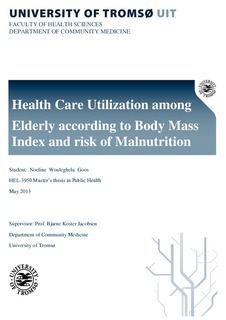| dc.contributor.author | Goos, Noeline Wouleghela | |
| dc.date.accessioned | 2017-06-07T12:39:01Z | |
| dc.date.available | 2017-06-07T12:39:01Z | |
| dc.date.issued | 2013 | |
| dc.identifier.citation | Goos, N. (2013) Health Care Utilization among Elderly According to Body Mass Index and Risk of Malnutrition. Mastergradsoppgave i folkehelsevitenskap. Universitetet i Tromsø (UiT); Norges arktiske universitet, Det helsevitenskapelige fakultet, Institutt for samfunnsmedisin. Hentet fra: http://hdl.handle.net/10037/7634 | |
| dc.identifier.uri | http://hdl.handle.net/11250/2445070 | |
| dc.description | Masterstudie, hvor hensikten var å undersøke sammenhengen mellom bruk av helsetjenester og underernæring blant eldre kvinner og menn (≥65 years). Data er hentet fra Tromsø-studien. | |
| dc.description.abstract | Background: malnutrition is prevalent among elderly, and this trend is projected to continue due increased life expectancy and more so, malnutrition has been attributed to morbidity and mortality. Further, investigations reveal that malnutrition is associated with prolonged hospital stay, use of emergency services and long term care services. The association between health care utilization and malnutrition will be explored in this study. Method: the study material was collected from the Tromsø 6 cross-sectional study. The study population is comprised of 4017 elderly women (53.5%) and men (46.5 %) aged ≥65 years. The assessment of malnutrition was effectuated by using the body mass index (BMI) and the Malnutrition Universal Screening Tool (MUST). The BMI was classified in to six categories, while the MUST derived three MUST score categories 0, 1, and 2+. The score 1 and 2+ indicated medium and high risk respectively. While taking into consideration some socio-economic and demographic variables, the exploration of the association between health care utilization (visit to GP or medical specialist last year or surgery the last three years) and nutritional assessment variables was accomplished using cross tabulation, analysis of variance (ANOVA) and logistic regression. Results: the respondents in the higher BMI categories were most likely to visit the GP, but no relationships were found between BMI and use of medical specialist or surgery during the last three years. Inconsistent associations were seen regarding risk of malnutrition and GP consultations, but there were indications that increased risk of malnutrition was associated with higher odds of surgery during the last three years and visit to the medical specialist last year. Discussion: the results suggest that BMI and MUST score is related to selected indicators of health care utilization, but in different directions. The cross-sectional design of the study limits the possibility for conclusions regarding causality. The results may also suggest that elderly subjects at high risk for malnutrition do not get sufficient attention in the primary health care. Search words: elderly, malnutrition, health care utilization, BMI, MUST. | |
| dc.language.iso | eng | |
| dc.relation.uri | http://hdl.handle.net/10037/7634 | |
| dc.subject | pasientsikkerhet | |
| dc.subject | sikkerhet | |
| dc.subject | helsevesen | |
| dc.subject | risiko | |
| dc.subject | pasienter | |
| dc.subject | eldre | |
| dc.subject | aldring | |
| dc.subject | kosthold | |
| dc.subject | mat | |
| dc.subject | ernæring | |
| dc.subject | underernæring | |
| dc.subject | body mass index | |
| dc.subject | kroppsmasseindeks | |
| dc.subject | BMI | |
| dc.subject | KMI | |
| dc.subject | MUST | |
| dc.subject | Malnutrition Universal Screening Tool | |
| dc.subject | forebygging | |
| dc.subject | underernæring | |
| dc.subject | screening | |
| dc.subject | ernæringsvurdering | |
| dc.subject | ernæringsstatus | |
| dc.subject | tverrsnitt | |
| dc.subject | tverrsnittstudie | |
| dc.subject | Tromsø | |
| dc.subject | Norge | |
| dc.title | Health care utilization among elderly according to body mass index and risk of malnutrition | |
| dc.type | Master thesis | |
| dc.rights.holder | Noeline Wouleghela Goos | |
